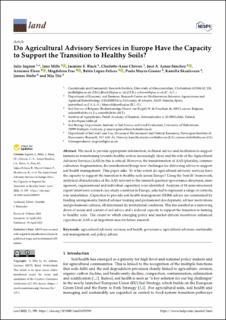Do Agricultural Advisory Services in Europe Have the Capacity to Support the Transition to Healthy Soils?
| dc.contributor.author | Ingram, Julie | |
| dc.contributor.author | Mills, Jane | |
| dc.contributor.author | Black, Jasmine E. | |
| dc.contributor.author | Chivers, Charlotte-Anne | |
| dc.contributor.author | Aznar-Sánchez, José A. | |
| dc.contributor.author | Elsen, Annemie | |
| dc.contributor.author | Frac, Magdalena | |
| dc.contributor.author | López-Felices, Belén | |
| dc.contributor.author | Mayer-Gruner, Paula | |
| dc.contributor.author | Skaalsveen, Kamilla | |
| dc.contributor.author | Stolte, Jannes | |
| dc.contributor.author | Tits, Mia | |
| dc.date.accessioned | 2022-10-11T08:11:14Z | |
| dc.date.available | 2022-10-11T08:11:14Z | |
| dc.date.created | 2022-04-20T09:09:12Z | |
| dc.date.issued | 2022-04-19 | |
| dc.identifier.citation | Land. 2022, 11 (5), 1-26. | en_US |
| dc.identifier.issn | 2073-445X | |
| dc.identifier.uri | https://hdl.handle.net/11250/3025285 | |
| dc.description.abstract | The need to provide appropriate information, technical advice and facilitation to support farmers in transitioning towards healthy soils is increasingly clear, and the role of the Agricultural Advisory Services (AAS) in this is critical. However, the transformation of AAS (plurality, commercialisation, fragmentation, decentralisation) brings new challenges for delivering advice to support soil health management. This paper asks: To what extent do agricultural advisory services have the capacity to support the transition to healthy soils across Europe? Using the ‘best fit’ framework, analytical characteristics of the AAS relevant to the research question (governance structures, management, organisational and individual capacities) were identified. Analysis of 18 semi-structured expert interviews across 6 case study countries in Europe, selected to represent a range of contexts, was undertaken. Capacities to provide soil health management (SHM) advice are constrained by funding arrangements, limited adviser training and professional development, adviser motivations and professional cultures, all determined by institutional conditions. This has resulted in a narrowing down of access and content of soil advice and a reduced capacity to support the transition in farming to healthy soils. The extent to which emerging policy and market drivers incentivise enhanced capacities in AAS is an important area for future research. | en_US |
| dc.language.iso | eng | en_US |
| dc.publisher | MDPI | en_US |
| dc.rights | Navngivelse 4.0 Internasjonal | * |
| dc.rights.uri | http://creativecommons.org/licenses/by/4.0/deed.no | * |
| dc.title | Do Agricultural Advisory Services in Europe Have the Capacity to Support the Transition to Healthy Soils? | en_US |
| dc.title.alternative | Do Agricultural Advisory Services in Europe Have the Capacity to Support the Transition to Healthy Soils? | en_US |
| dc.type | Peer reviewed | en_US |
| dc.type | Journal article | en_US |
| dc.description.version | publishedVersion | en_US |
| dc.rights.holder | © 2022 by the authors | en_US |
| dc.source.pagenumber | 1-26 | en_US |
| dc.source.volume | 11 | en_US |
| dc.source.journal | Land | en_US |
| dc.source.issue | 5 | en_US |
| dc.identifier.doi | 10.3390/land11050599 | |
| dc.identifier.cristin | 2017744 | |
| dc.relation.project | EC/H2020/677407 | en_US |
| dc.source.articlenumber | 599 | en_US |
| cristin.ispublished | true | |
| cristin.fulltext | original | |
| cristin.qualitycode | 1 |
Tilhørende fil(er)
Denne innførselen finnes i følgende samling(er)
-
Divisjon for miljø og naturressurser [756]
Publikasjoner knyttet til ansatte ved Divisjon for miljø og naturressurser -
Publikasjoner fra CRIStin - NIBIO [4575]
-
Vitenskapelige artikler [1416]

